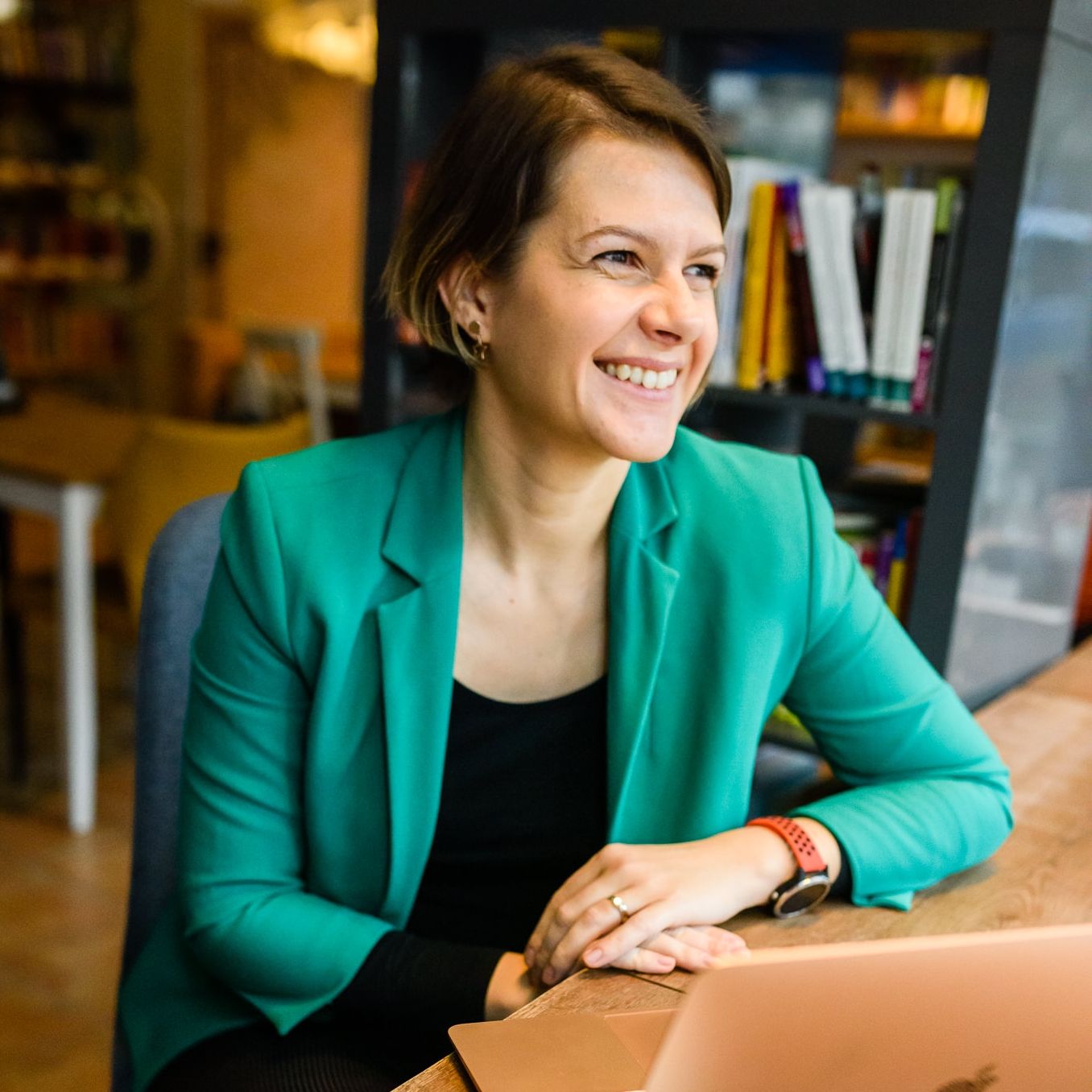Social media marketing isn’t just about posts—it’s about strategy and results. The best way to learn? Social media case studies that reveal how brands turn engagement into impact. From viral trends to influencer power plays, these success stories offer a blueprint for digital success.
But the ones that really shed some light and insights about today's best practices in social are the best ones that go beyond vanity metrics, showing how social media marketing drives real ROI.
This article breaks down the smartest campaigns, uncovering what worked, why it mattered, and how you can apply it to your own strategy. Let’s dive in!
Social media case studies across different industries
#1. Food: Lay's "Do Us a Flavor" Campaign
#2. Jewelry: Tiffany & Co.'s "Believe in Love" Campaign
#3. Restaurants & Cafes: Chipotle's #ChipotleLidFlip Campaign
#4. Beauty & Cosmetics: Sephora's Virtual Artist Campaign
#5. E-commerce: ASOS's #AsSeenOnMe Campaign
#6. Alcohol: Guinness's "Made of More" Campaign
#7. Fashion: Gucci's TikTok and AR Campaign
#8. Airlines: KLM's "Meet & Seat" Campaign
#9. Automotive: Mercedes-Benz's #MBPhotoPass Campaign
#10. IKEA's Place AR App Campaign
#11. Hospitality & Hotels: Marriott's Travel Brilliantly Campaign
#12. NGO: UNICEF Sweden's "Likes Don't Save Lives" Campaign
#13. Travel: Expedia's "Made to Travel" Campaign
#14. Appliances: Samsung's AR Innovation
#15. Beverages: Coca-Cola's "Taste the Feeling" Campaign
#1. Food: Lay's "Do Us a Flavor" Campaign
When it comes to using the power of user-generated content (UGC), Lay's created a content strategy that would become a social media case study for countless brands.
Their approach? Turn customers into product developers and brand storytellers.
Launched for the first time in July 2012, and revived in October 2024, the "Do Us a Flavor" campaign invited customers to create new potato chip flavors through multiple channels, focusing on direct consumer engagement rather than influencer partnerships or sophisticated technology.
Objectives:
- Strengthen customer engagement and brand loyalty;
- Generate widespread publicity for Lay's;
- Tap into consumer preferences for new flavor development;
- Create a multi-platform social media presence.
Social media channels:
- Instagram and Facebook for visual storytelling and UGC
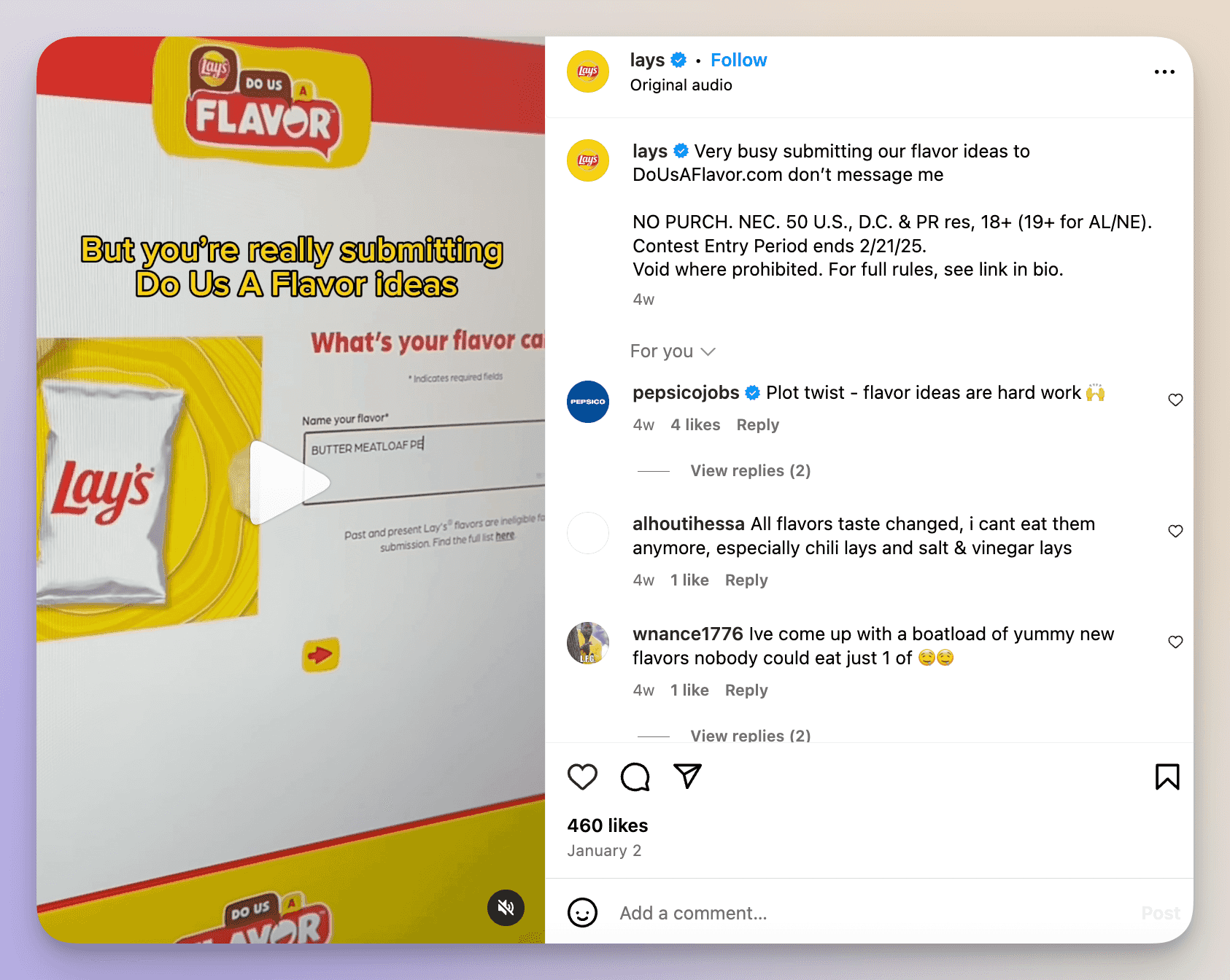
Other channels:
- Submission and voting through custom website (DoUsAFlavor.com)
Social media tactics:
- Short-form video content through Reels;
- User-generated flavor suggestions and reviews;
- Nostalgic content featuring past winning flavors;
- Relatable content about snacking moments;
- Community engagement through comments.
This social media marketing campaign case study had impressive outcomes in the past, with over 3 million flavor submissions across 30 countries, a 12% increase in sales across participating markets, and 68% of participants reported a stronger brand connection.
For the most recent edition, let’s examine the results in real-time through the Socialinsider dashboard. Here’s a summary of the performance of the posts in the campaign compared to other content pillars.
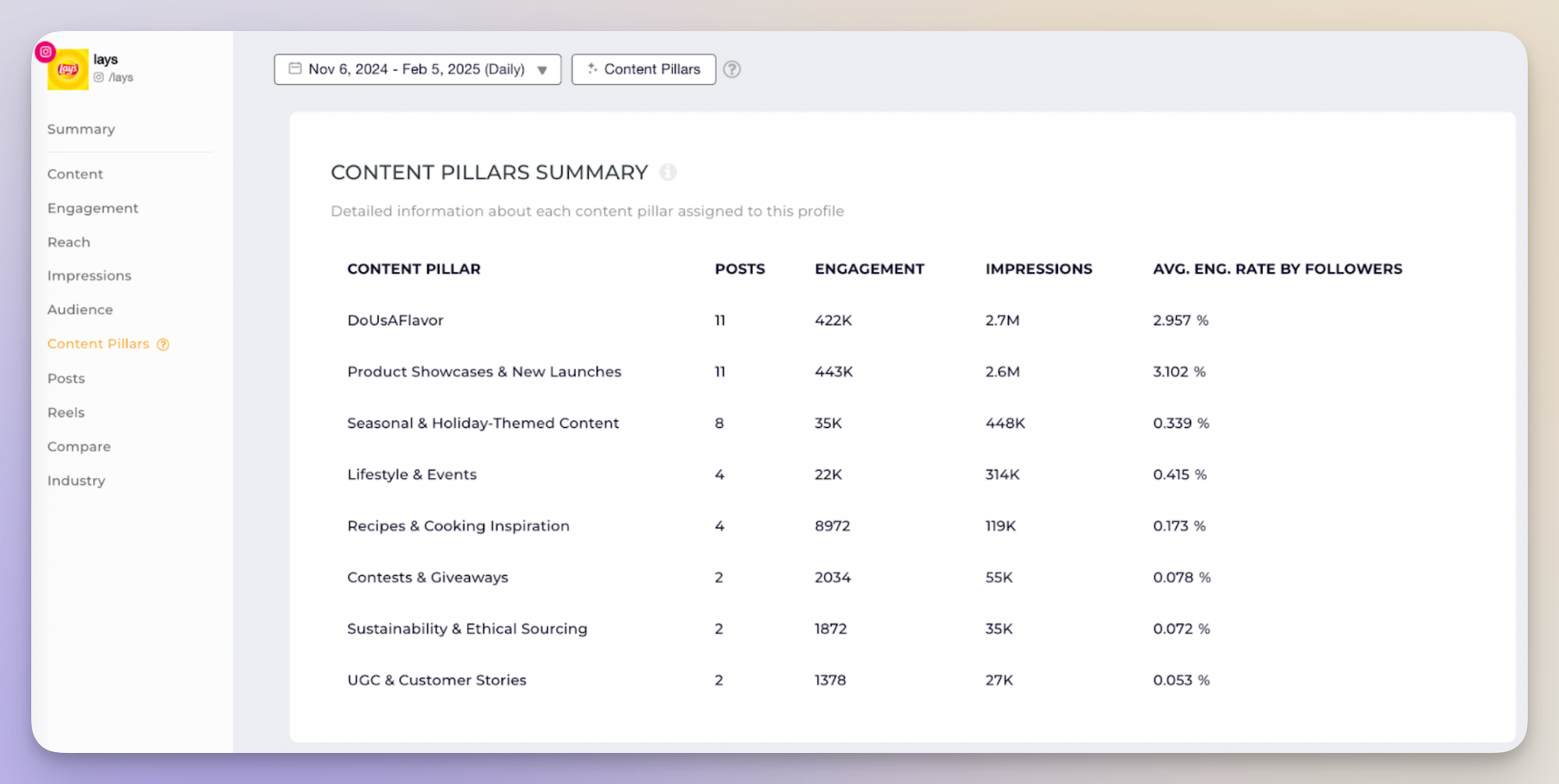
3 key lessons for social media managers:
- Revive winning formats. The success of bringing back "Do Us a Flavor" shows that updating proven campaigns for current platforms can be more effective than creating from scratch.
- Short-form video drives participation. Converting the traditional submission process into Reel-friendly content increased engagement and made participation more appealing.
- Nostalgia boosts social media reach and engagement. Featuring past winning flavors created an emotional connection while driving interest in new submissions.
💡Insider tip: The success of this brand strategy case study shows that effective social media campaigns should evolve with their audiences. Lay's continually refreshed its approach, from simple flavor submissions to producing Reels and encouraging UGC, keeping the campaign fresh across multiple years.
Want to analyze your campaign performance like a pro? Access comprehensive social media analytics and create your own compelling case studies.
#2. Jewelry: Tiffany & Co.'s "Believe in Love" Campaign
This social media marketing strategy case study demonstrates how a luxury brand can blend celebrity power with authentic storytelling.
Tiffany & Co.'s approach was to create an inclusive narrative around love while maintaining its premium positioning.
Launched in 2017, the "Believe in Love" campaign reimagined traditional engagement ring marketing by featuring diverse real couples and powerful musical storytelling through partnerships with Alicia Keys and later Lady Gaga.
Objectives:
- Modernize the brand's image while preserving its luxury heritage;
- Connect with younger, diverse audiences;
- Create emotional resonance through authentic storytelling;
- Strengthen brand association with meaningful life moments;
Social media channels:
- Instagram and Facebook for visual storytelling and couple features;
- YouTube for campaign films and music content;
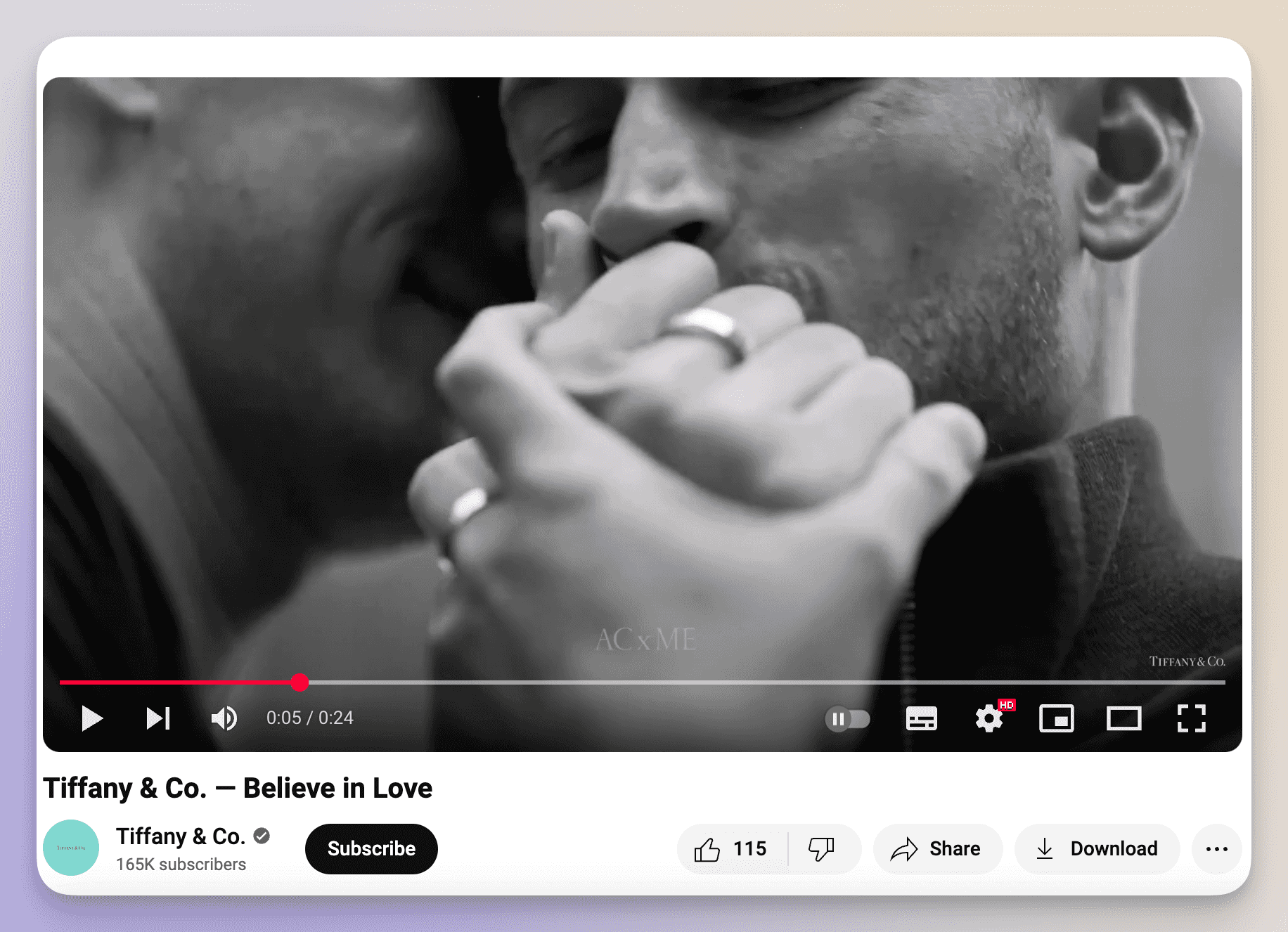
Other channels:
- Traditional luxury media;
- Print photography;
- In-store displays.
Social media tactics:
- Celebrity partnerships with Alicia Keys and Lady Gaga;
- Multi-layer digital storytelling featuring real couples;
- High-quality visual content showcasing hand imagery;
- Behind-the-scenes content with featured couples.
This content strategy created significant results:
- Featured diverse couples across different backgrounds;
- Generated organic coverage in luxury and lifestyle media;
- Established new brand positioning in the engagement ring market.
3 key lessons for social media managers:
- Authenticity elevates luxury while making it more approachable: Featuring real couples alongside celebrities created relatable yet aspirational content.
- Music amplifies emotion: The strategic use of iconic songs and artists enhanced the campaign's emotional impact.
- Visual consistency and quality matter: Professional photography maintains brand luxury while telling inclusive stories.
💡 Insider tip: This social media marketing strategy case study proves that less is more in luxury social media. Tiffany & Co.'s social posts maintained sophistication through simple, uncluttered visuals and minimal text. Even with celebrity partnerships and diverse stories, each post adhered to its clean, elegant aesthetic, proving that simplicity in social media can actually amplify your message.
#3. Restaurants & Cafes: Chipotle's #ChipotleLidFlip Campaign
Chipotle's #ChipotleLidFlip social media case study showcases how turning an employee's casual skill into a viral moment can create authentic engagement.
The company managed to successfully transform everyday restaurant actions into viral social media entertainment — enviable, we know.
Launched in May 2019, the campaign capitalized on a Chipotle employee's unique lid-flipping technique, turning it into a TikTok challenge that would captivate Gen Z audiences.
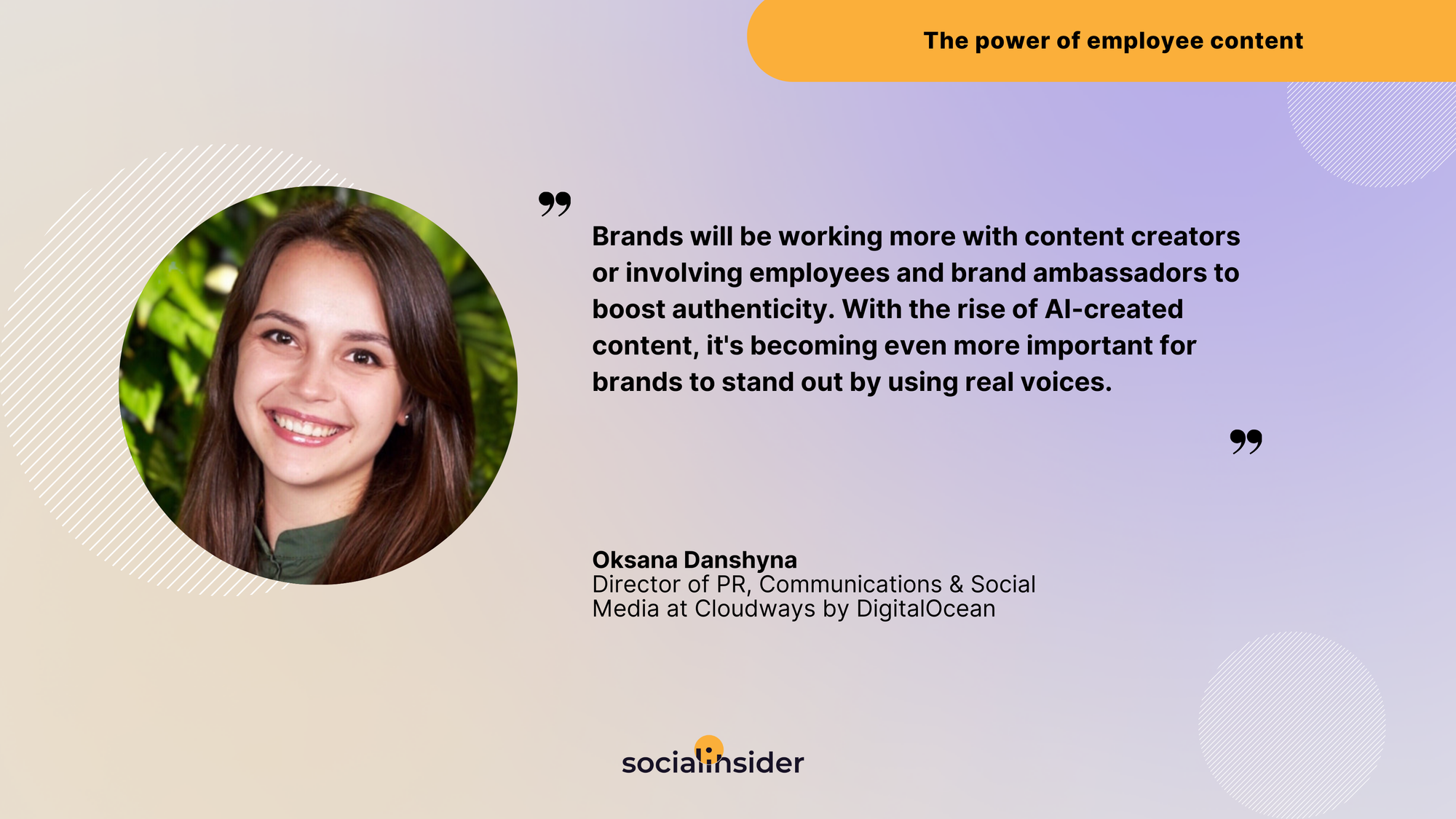
Objectives:
- Drive digital order sales;
- Increase app downloads;
- Boost brand relevance among Gen Z through UGC.
Social media channels:
- TikTok as primary platform;
- Instagram for cross-promotion;
- YouTube through influencer partnership.
Other channels:
- Chipotle app;
- Digital ordering platform;
- In-store promotion.
Social media tactics
- Influencer partnership with David Dobrik (already a known fan of the brand), who launched his TikTok account with the #ChipotleLidFlip challenge;
- Authentic, employee-inspired challenge format;
- Hashtag strategy with #ChipotleLidFlip;
- Cinco de Mayo timing tie-in with free delivery promotion for digital orders.
This social media marketing case study achieved remarkable results:
- 111,000 video submissions in the first six days;
- 104 million views within week one;
- 230 million views after one month;
- Record-breaking digital sales days.
3 key lessons for social media managers:
- Employee content can spark gold. The most authentic brand moments often come from within your own team, so pay attention to what your employees are doing naturally.
- Authentic partnerships matter. Choosing David Dobrik, a genuine Chipotle fan who already had an appeal with the Gen Z audience, made the campaign feel natural rather than forced.
- Timing amplifies impact. Launching during Cinco de Mayo and as David Dobrik's first TikTok post provided an extra boost to engagement.
💡 Insider tip: This content strategy case study shows that successful social media challenges don't need complex rules or elaborate setups. The simple lid flip was easy to replicate and fun, making it perfect for TikTok's format. When launching your own challenges, focus on actions that are simple enough for anyone to try but satisfying enough to share.
#4. Beauty & Cosmetics: Sephora's Virtual Artist Campaign
Sephora's Virtual Artist Campaign case study shows how AR technology can solve a real customer pain point. Their approach was to turn smartphones — which are very accessible to clients — into virtual makeup mirrors.
Launched in 2016, this innovative AR filter within Sephora's mobile app changed how customers shop for makeup by enabling virtual product try-ons, becoming one of the continuous innovations the brand came up with over the years.
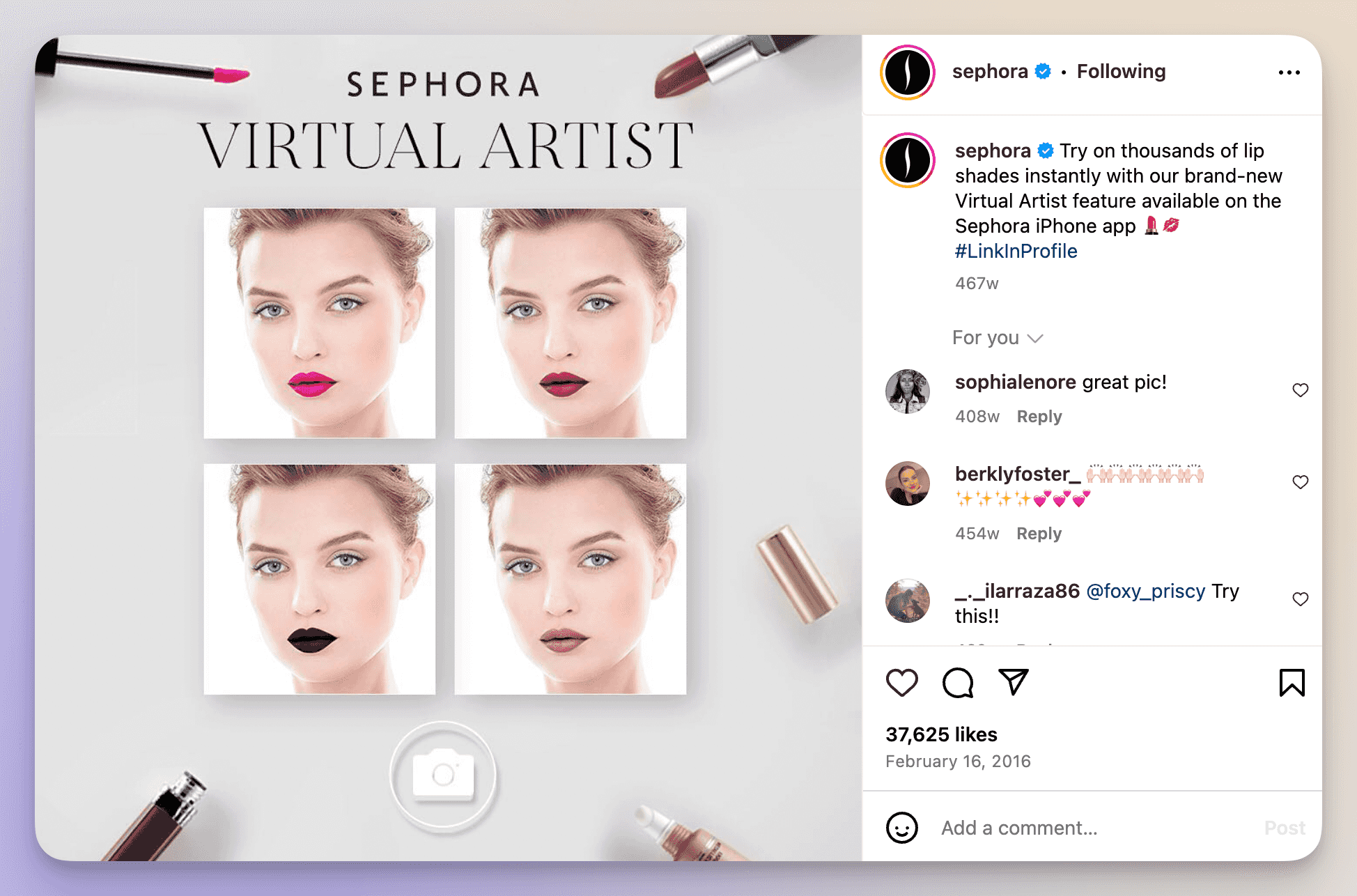
Objectives:
- Reduce uncertainty in online makeup purchases;
- Decrease product return rates;
- Drive mobile app engagement;
- Increase online sales conversion;
- Bridge digital and in-store experiences.
Social media channels:
- Instagram for AR filter sharing;
- Facebook for community engagement;
- TikTok for fun challenges and tutorial content.
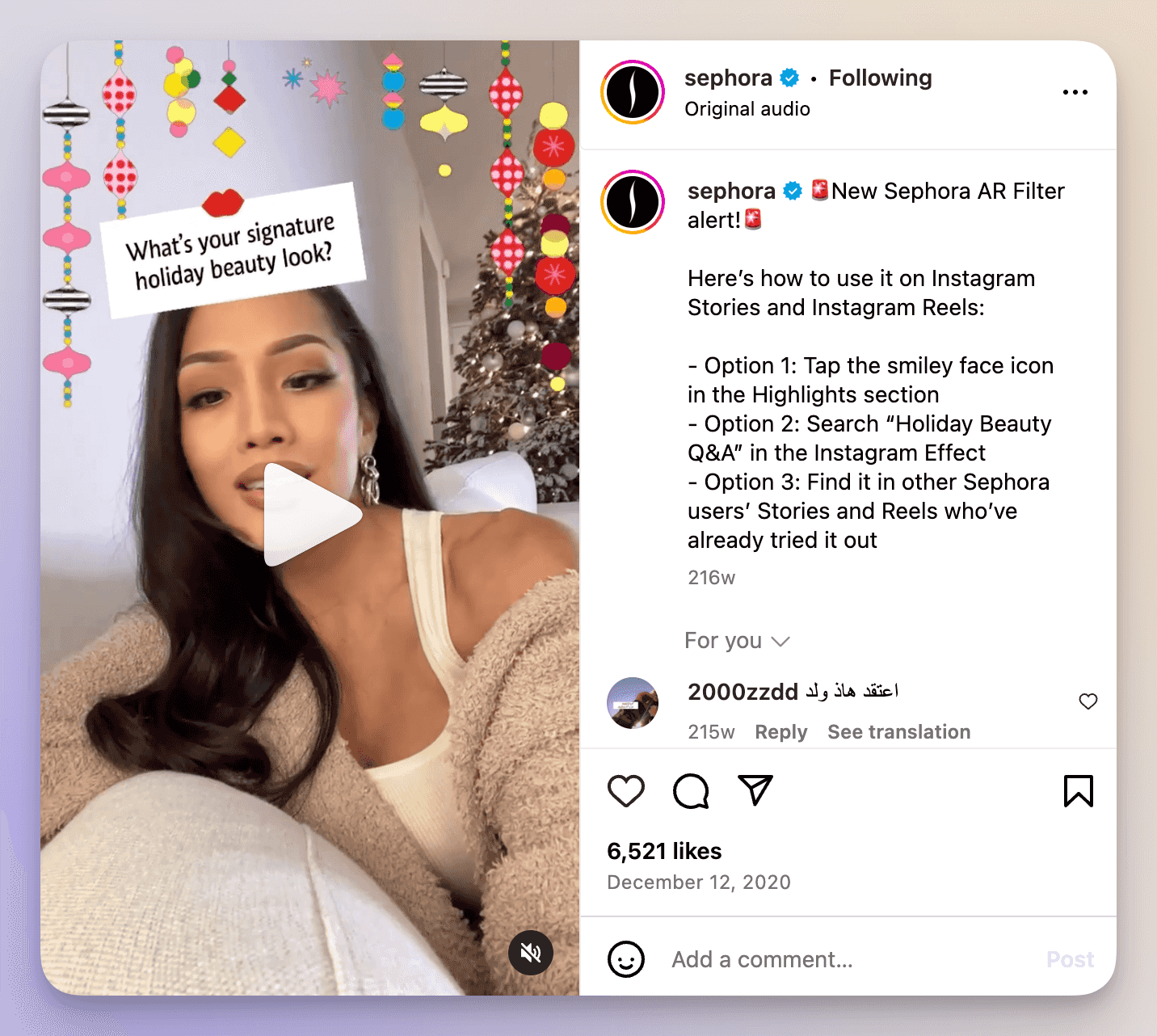
Other channels:
- Sephora mobile app;
- Website integration.
Social media tactics:
- Virtual try-on sharing functionality;
- Beauty tutorial integration with AR technology;
- Photo sharing of virtual looks;
- Direct purchase integration with try-ons.
The social media strategy delivered great results:
- 35% increase in online makeup sales;
- 25% boost in add-to-basket rate;
- Over 20 million feature downloads;
- Reduced return rates.
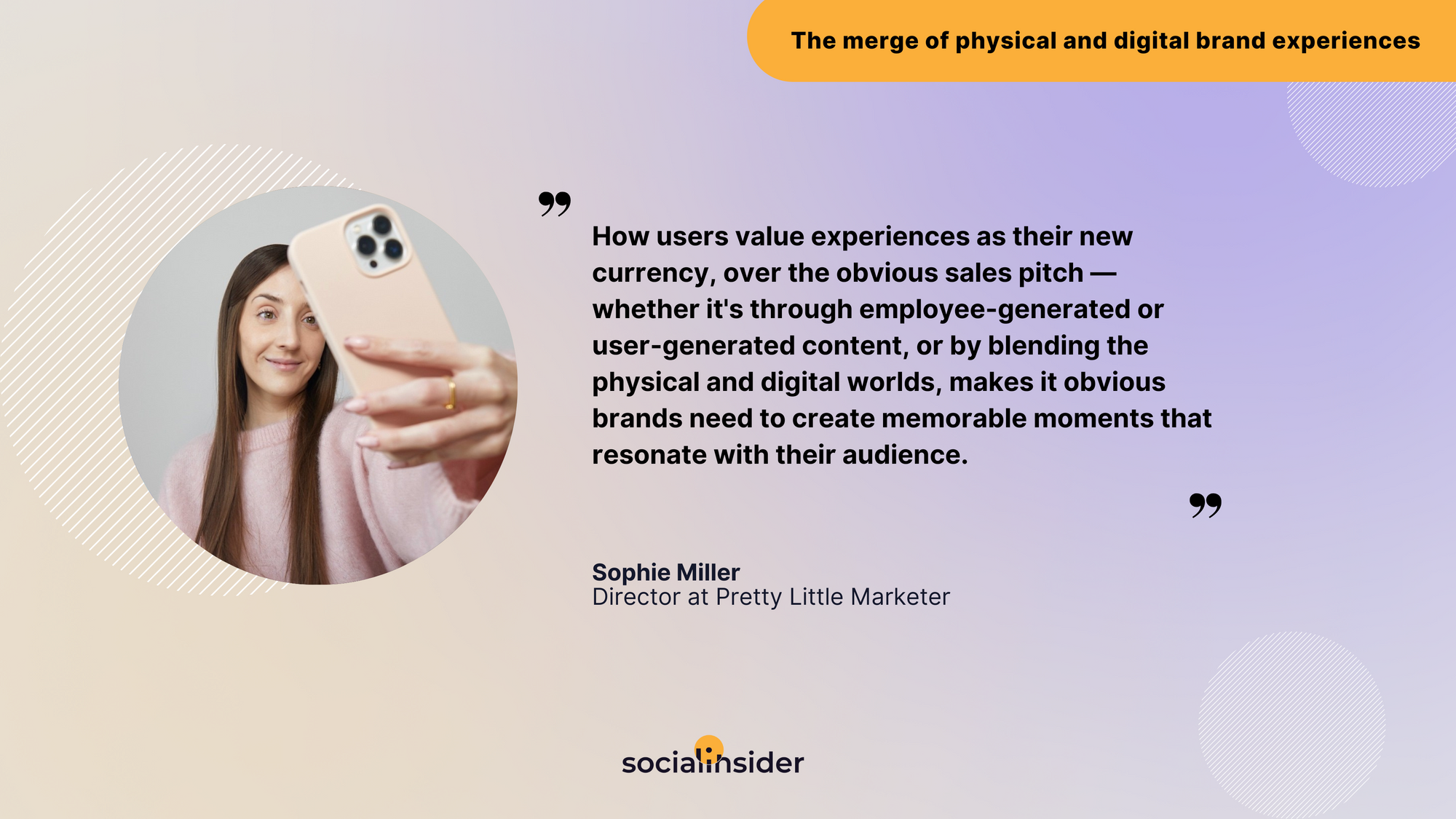
3 key lessons for social media managers:
- Solve real problems. The AR filter wasn't just a gimmick but addressed a genuine customer pain point of not being able to try products online.
- Make sharing seamless. Enabling users to easily share their virtual try-ons amplified organic reach.
- Cross-platform content opportunity. An AR feature can generate content for multiple platforms — from Instagram AR filters to TikTok tutorials and Pinterest inspiration boards.
💡 Insider tip: This social media marketing case study demonstrates that utility comes first and entertainment second. Sephora's success came from focusing on using technology to provide real value. When developing AR content for social media, prioritize practicality rather than just creating a fun filter.
#5. E-commerce: ASOS's #AsSeenOnMe Campaign
A social media case study that shows how UGC can transform an online shopping experience. ASOS managed to turn customers into content creators and brand ambassadors, which is something all brands aspire to.
Launched in 2014, the #AsSeenOnMe campaign reimagined product imagery by encouraging ASOS customers to share their personal styling of products, creating a more authentic shopping experience.
Objectives:
- Increase customer engagement;
- Drive organic social media traffic;
- Generate authentic marketing content;
- Enhance the online shopping experience;
- Build a community around the brand.
Social media channels:
- Instagram as the primary platform.
Other channels:
- ASOS website's dedicated "As Seen on Me" section.
Social media tactics:
- Customer photo sharing with #AsSeenOnMe;
- Featured user content on official brand accounts;
- Curated content selection by the ASOS team;
- Website integration of UGC content.
A marketing case study with exceptional results:
- 1.4 million posts were generated by 2021 by the dedicated hashtag (source) — and posts are being generated to this day
- 2% boost in average cart value (source)
3 key lessons for social media managers:
- Make customers the stars. Featuring real people wearing your products creates authenticity and trust.
- Integrate UGC strategically. Incorporating customer content directly into the shopping experience drives conversions.
- Use an intuitive hashtag. #AsSeenOnMe was simple, memorable, and clearly communicated what the campaign was about. It's no wonder people adopted it and kept using it ten years later.
💡 Insider tip: While getting tons of UGC is great, quality is also key. ASOS's success came from carefully curating UGC, ensuring quality content while maintaining authenticity. This balanced approach helps maintain brand standards while celebrating customer creativity.
#6. Alcohol: Guinness's "Made of More" Campaign
Guinness's "Made of More" campaign shows how emotional storytelling can evolve across time and platforms.
Launched in 2012 as a traditional TV campaign, "Made of More" gained new life in 2018 when Guinness reimagined it for social media through the story of the Compton Cowboys.
The campaign's transformation from cinematic TV spots to platform-specific social content demonstrated how classic brand storytelling can adapt to changing media consumption.
Objectives:
- Build long-term brand equity;
- Create an emotional connection with audiences;
- Protect market share;
- Reduce price sensitivity;
- Increase brand awareness;
Original channels (2012):
- Television commercials;
- Cinema advertising;
- Traditional media;
Social media expansion (2018)
- Facebook for immersive storytelling;
- Instagram (first UK/Ireland 60-second ad);
- YouTube for full-version videos.
Social media tactics:
- Vertical video format for mobile consumption;
- Platform-specific content creation;
- Bold white typography overlays on videos;
- Short, theme-focused vignettes;
- Cross-platform storytelling integration;
- Documentary-style content;
- Multi-channel content ecosystem.
"Made of More" was an award-winning campaign that delivered significant results:
- Generated £3.88 profit ROI per £1 spent;
- Delivered an estimated £1 billion in brand value;
- Enhanced brand effectiveness globally.
3 key lessons for social media managers:
- Authentic storytelling works. Connecting brand messages to human stories creates deeper resonance.
- Strong campaigns can evolve. The "Made of More" message stayed constant while the storytelling formats adapted to new platforms.
- Local stories can have a global impact. Stories like "Sapeurs" and "Compton Cowboys" resonated across different markets through their universal, emotional value.
💡 Insider tip: This social media case study proves you shouldn't toss campaigns into the archive bin. Instead of starting from scratch, use social media analytics to understand what worked and reuse the powerful core message and tactics of successful campaigns. Only adapt the format and approach for new channels and habits.
#7. Fashion: Gucci's TikTok and AR Campaign
Our analysis of Gucci's TikTok and AR campaign demonstrates how a luxury brand successfully connected with Gen Z audiences by blending high fashion with playful, interactive digital experiences.
Launched through multiple initiatives on TikTok and AR platforms, Gucci transformed traditional luxury marketing.
Objectives:
- Engage with younger audiences;
- Drive brand awareness;
- Enable virtual product trials;
- Drive sales through AR integration.
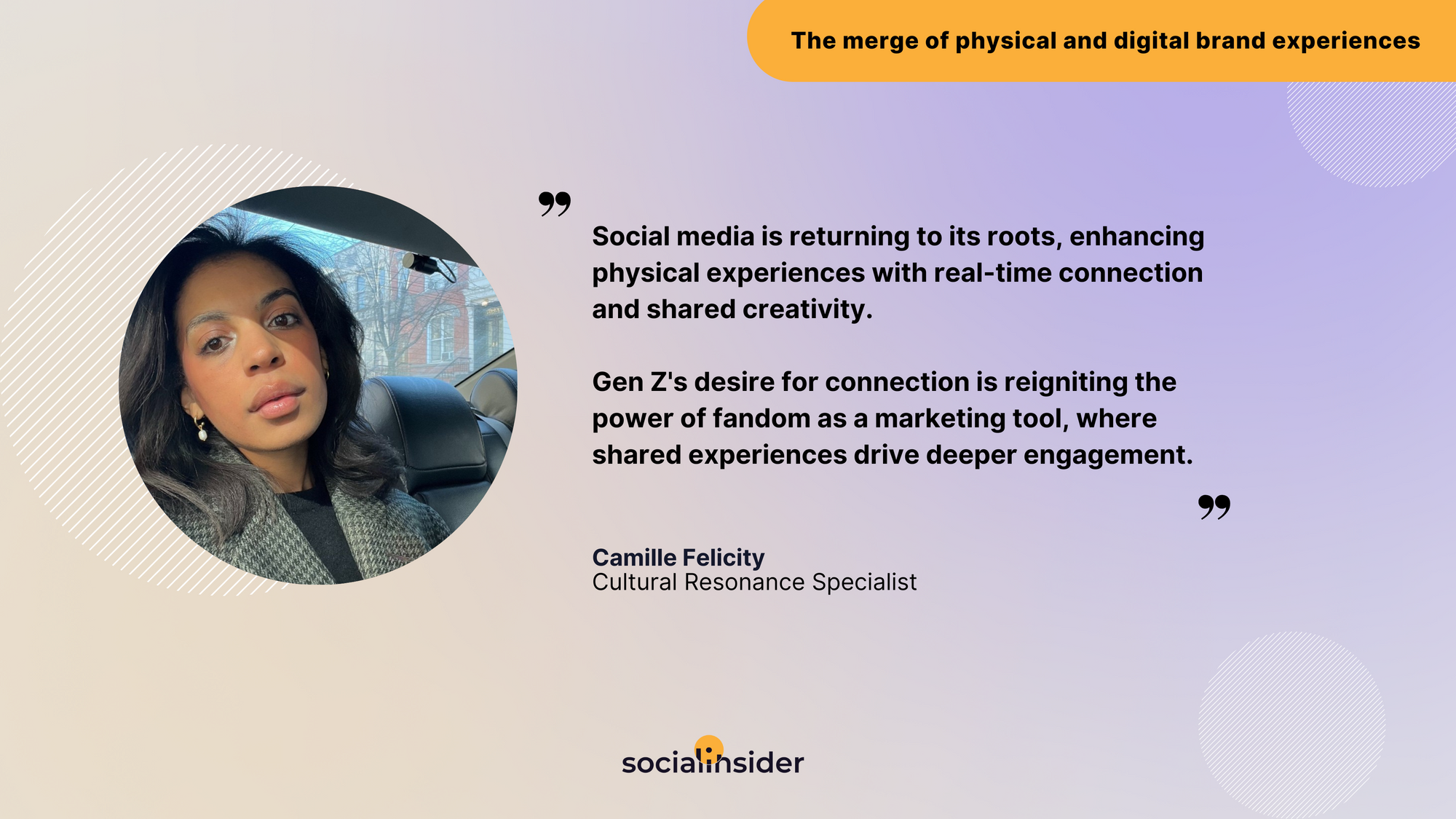
Social media channels:
- TikTok for viral challenges
- Snapchat for AR experiences
- WeChat and Tmall for hyper-realistic 3D engagements
Other channels:
- E-commerce integration
- Shoppable AR interfaces
Social media tactics:
- #GucciModelChallenge inviting users to mimic the brand's style;
- #AccidentalInfluencer challenge for Tennis 1977 sneakers;
- AR shoe try-on campaign on Snapchat;
- Virtual jewelry try-on on Tmall and WeChat;
- Shoppable AR with direct purchase integration;
- A mix of creative and promotional videos;
- User-generated content encouragement.
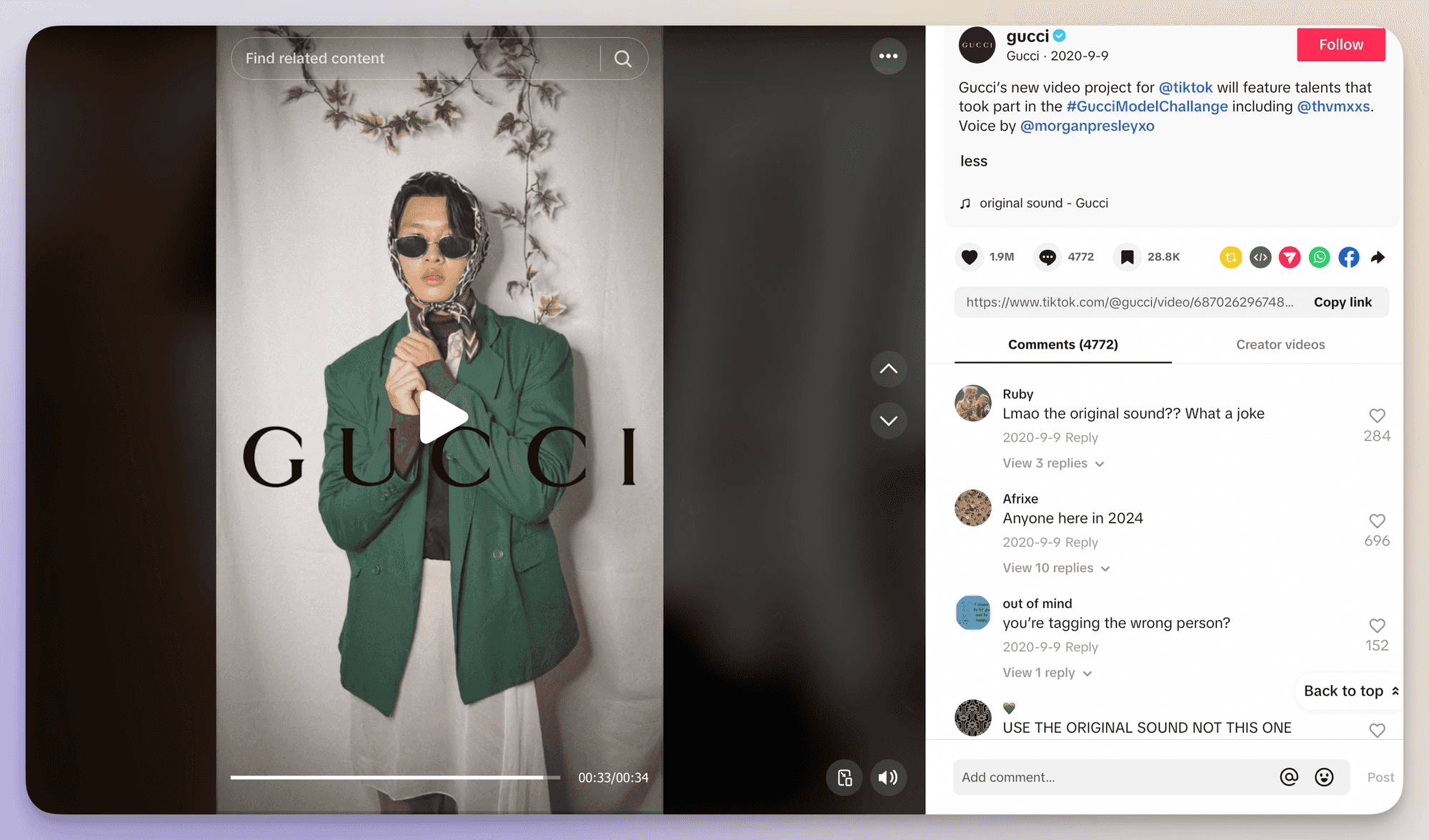
This social media case study boasts enviable results:
- 2.5 billion views on the Snapchat AR campaign;
- 2.3 million user-generated videos;
- 18% increase in brand awareness;
- Global reach across multiple platforms.
3 key lessons for social media managers:
- Luxury can be playful. High-end brands can maintain prestige while creating engaging social experiences.
- Technology drives accessibility. AR try-ons made luxury products more approachable for younger audiences.
- Interactive features boost engagement. Combining AR with social challenges created multiple touchpoints for user participation.
💡 Insider tip: This social media case study shows that brands need to meet their audience where they are. Gucci's success came from understanding that Gen Z expects interactive, playful content, and they delivered without compromising their premium positioning.
#8. Airlines: KLM's "Meet & Seat" Campaign
KLM's "Meet & Seat" campaign really took off. The airline managed to transform flights into networking opportunities by connecting passengers before takeoff.
Launched in 2012, this program integrated social media profiles with flight bookings, allowing passengers to choose seats based on shared interests and professional backgrounds. Ingenious, huh?
The social media integration expanded systematically. Initially launched on routes to San Francisco, New York, and São Paulo, it later added 10 additional destinations.
Objectives:
- Enhance passenger experience;
- Personalize air travel;
- Differentiate KLM's service offering;
- Drive social media engagement.
Social media channels:
- LinkedIn for professional networking
- Facebook for social connections
Oher channels:
- KLM booking system
- Flight reservation platform
Social media tactics
- Social profile integration with bookings;
- Optional profile information sharing;
- Pre-flight passenger matching;
- Professional networking facilitation;
- Privacy control features.
3 key lessons for social media managers:
- Think beyond the platform. Social media can enhance real-world experiences, not just digital ones.
- Prioritize user control. Letting passengers choose what information to share built trust.
- Start small, scale smart. Testing on key routes before expanding helped refine the program.
💡Insider tip: KLM's success came from understanding that social connections are most meaningful when they serve a practical purpose — in this case, making long flights more engaging and productive. When creating social media experiences, focus on adding real value to customers' lives.
#9. Automotive: Mercedes-Benz's #MBPhotoPass Campaign
This social media case study illustrates how a luxury car brand reimagined influencer marketing.
Mercedes-Benz handed over the social media keys to storytellers who could capture authentic adventures with their vehicles.
Launched in 2014 and revived in 2024, the #MBPhotoPass campaign transformed traditional automotive marketing by letting influencers and photographers document their personal Mercedes-Benz experiences, targeting the "Generation Benz" aged 20-39.
Objectives:
- Create authentic, engaging content;
- Challenge luxury car driver stereotypes;
- Reach younger audiences;
- Insert brand into daily life narratives;
- Generate and leverage UGC.
Social media channels:
- Instagram as the primary platform;
- Facebook for wider reach;
- YouTube for video content.
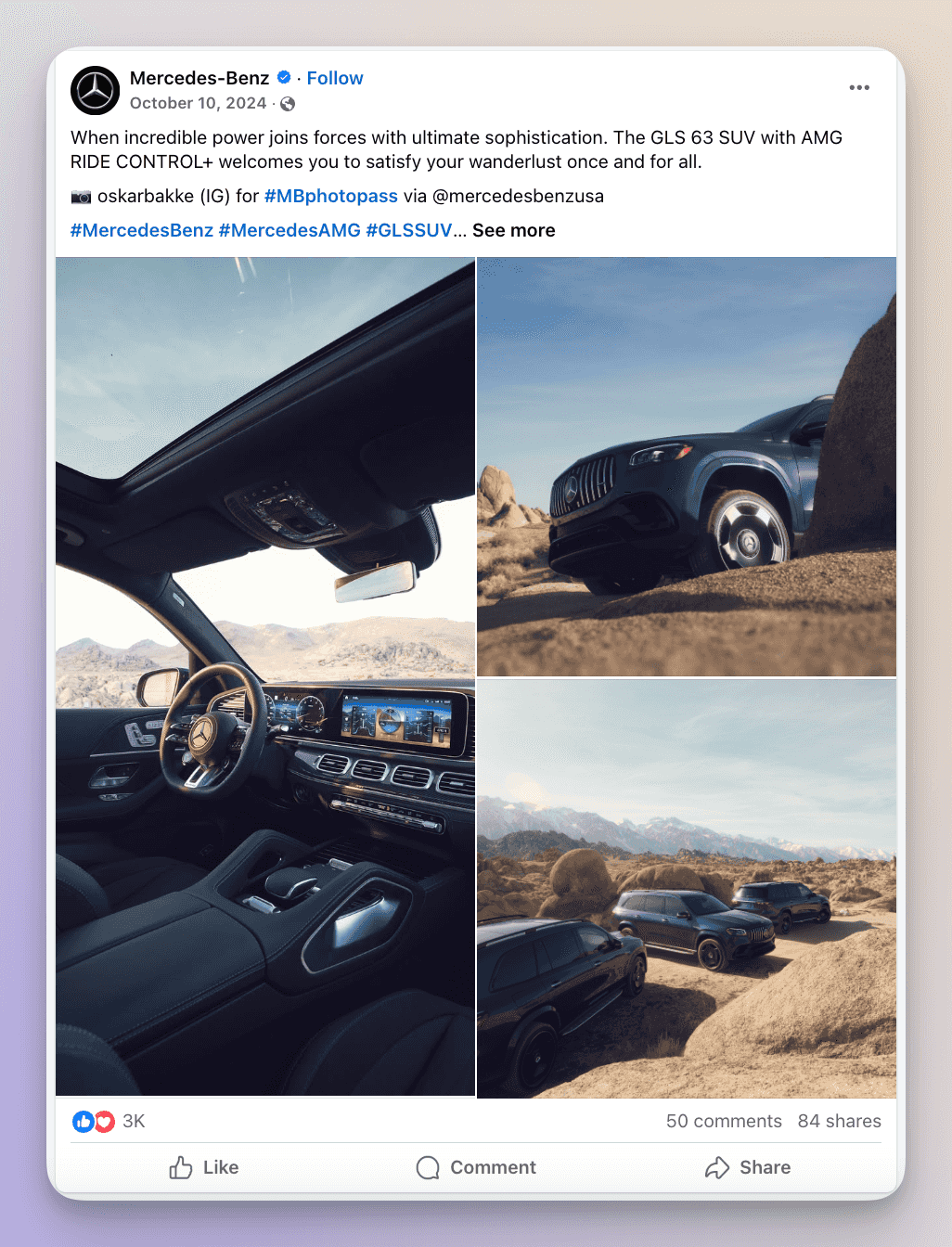
Social media tactics:
- Influencer account takeovers;
- 360-degree video content;
- Diverse storytelling approaches;
- Location-based content creation;
- Quality imagery of products;
- Cross-platform content sharing;
- Consistent hashtags and keywords for campaign recognition.
This content strategy delivered impressive results when first launched, with 269 images posted, 173 million total impressions, 2.3 million likes/comments, and over $4 million in earned media.
Wondering how the most recent campaign did? Socialinsider helps you track results based on hashtags and content pillars so you can monitor your brand’s performance — or the competition’s — in real time.
For example, below, you can see the most popular and engaging posts from the latest 2024 #MBPhotoPass campaign — and those are some impressive numbers. If needed, you can drill down the list or analyze each post’s performance in detail.
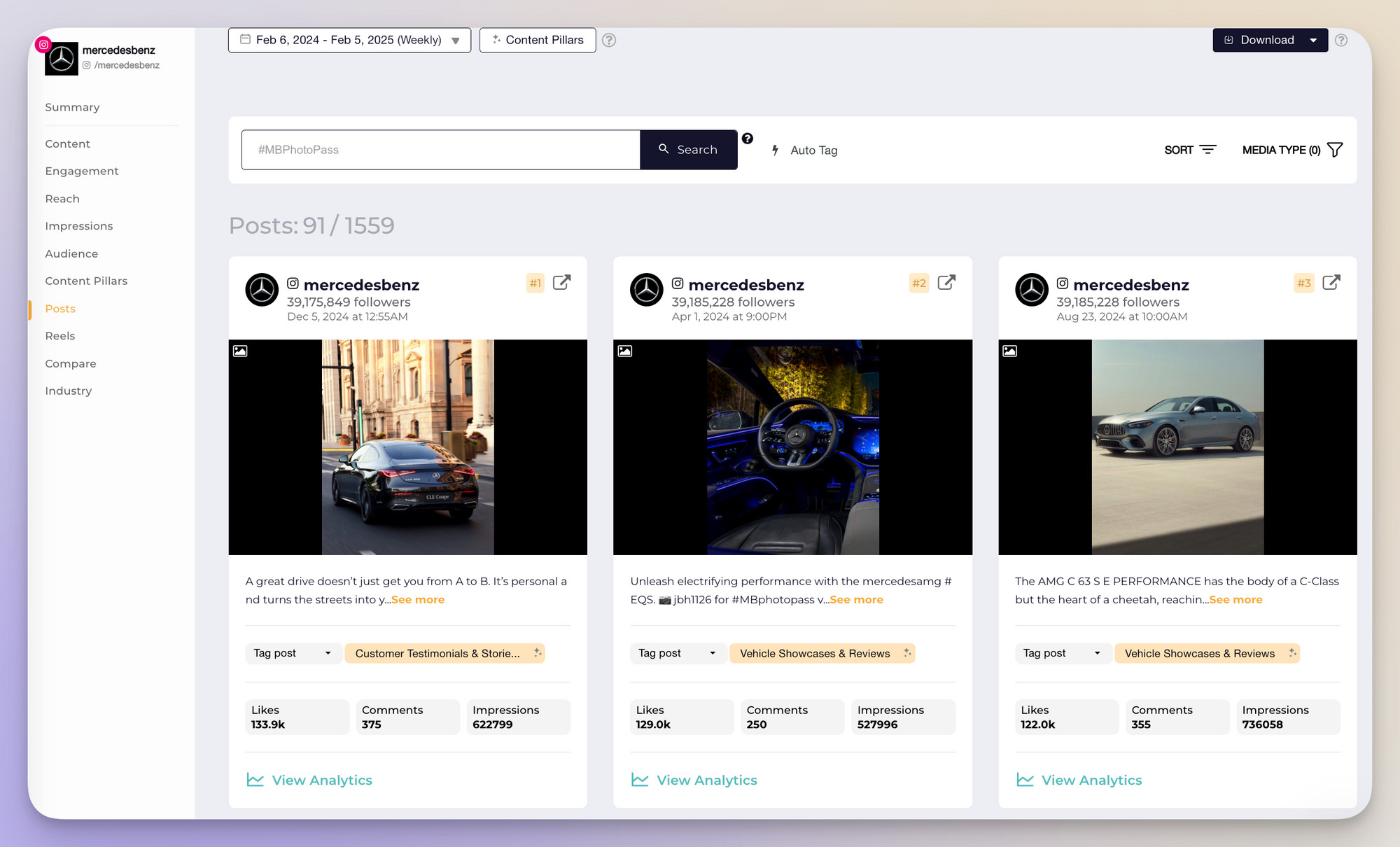
3 key lessons for social media managers:
- Trust your storytellers. Giving influencers creative freedom resulted in more authentic content.
- Diversity drives engagement. From Loki the dog to family road trips, varied perspectives kept content fresh.
- Data informs storytelling. Track performance by content pillars and themes to understand which stories resonate most with your audience and optimize future campaigns accordingly.
💡 Insider tip: Successful influencer campaigns don't need to control every aspect. Choose the right creators and let them tell genuine stories rather than dictating strict brand guidelines.
#10. Interior Design: IKEA's Place AR App Campaign
Moving furniture around just to see if it fits? IKEA had a better idea. This social media marketing case study reveals how AR technology transformed the furniture buying experience.
Launched in 2017, IKEA Place rearranged the rules of furniture shopping by combining AR technology with social sharing capabilities, making interior design decisions more confident and collaborative.
Objectives:
- Reduce purchase uncertainty
- Transform the furniture shopping experience
- Drive customer confidence
- Enhance digital presence
- Bridge online and offline shopping
Social media channels:
- Integrated social sharing features
- Cross-platform image sharing
- Video content distribution on Facebook, Instagram, and YouTube
Other channels:
- iOS app (iPhone 6S and newer)
- Android app
- IKEA website integration
Social media tactics:
- Shareable AR visualization;
- True-to-scale 3D models;
- Room scene sharing;
- Social proof through user shares;
- Visual decision-making tools.
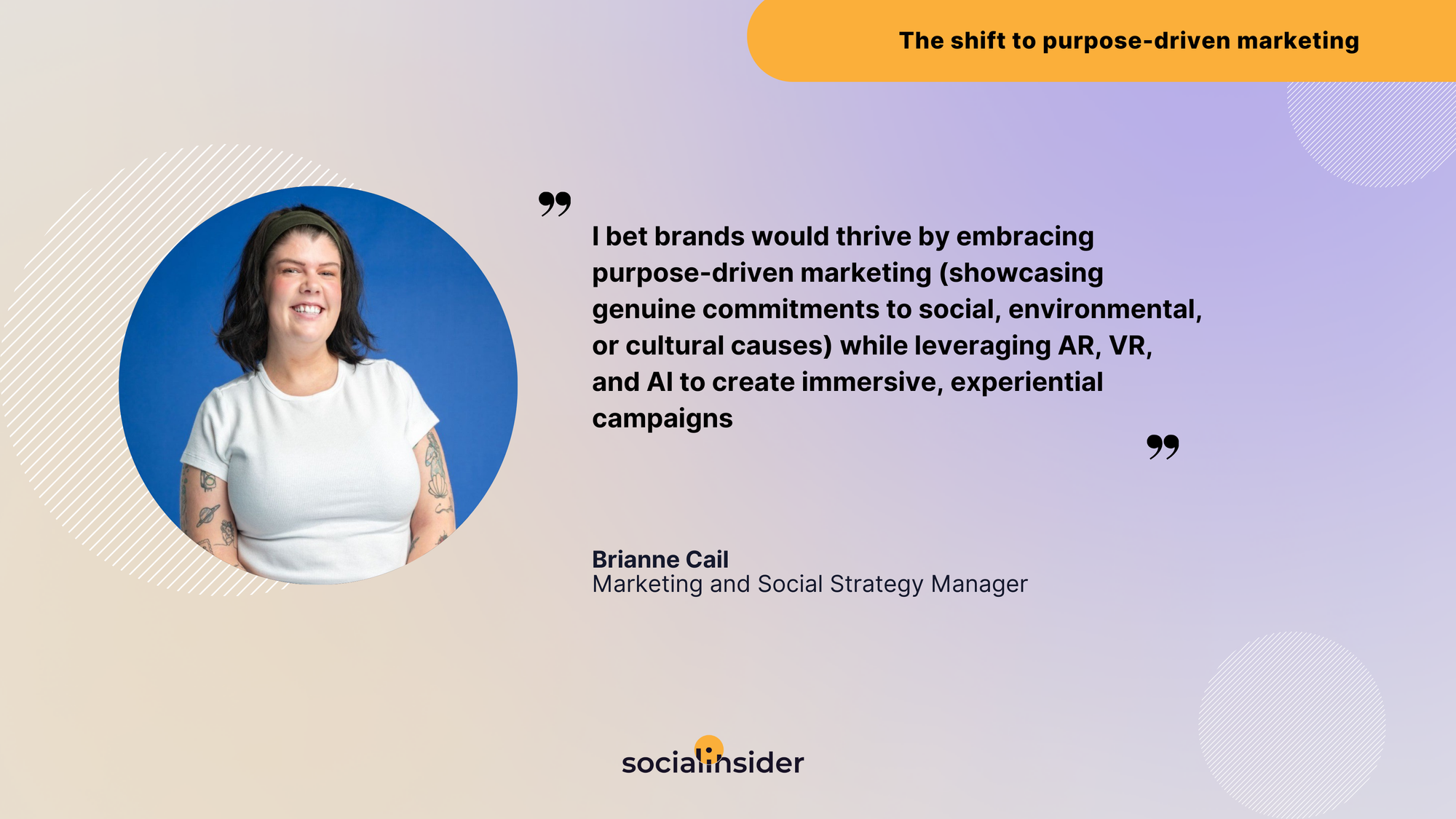
The results speak for themselves:
- The second most popular free ARKit app on Apple's platform
- Contributed to 73% growth in online sales (as reported in 2021)
- Online sales reached 26% of total sales
- Improved customer shopping experience and strengthened digital transformation strategy
3 key lessons for social media managers:
- Solve real problems. Create digital experiences that address genuine customer pain points.
- Make sharing intuitive. For IKEA, built-in sharing features turned personal shopping decisions into social content.
- Focus on accuracy. Make sure the technology you use is reliable. IKEA's high-precision AR built trust in the digital experience.
💡 Insider tip: First-mover advantage matters. Being an early AR adopter positioned IKEA as an innovative leader, garnering significant media attention and respect from other players in the industry. Don't be afraid to test and experiment with new platforms and content formats early, and you might become the next successful case study that competitors model.
#11. Hospitality & Hotels: Marriott's Travel Brilliantly Campaign
Beyond booking rooms and earning points, Marriott saw an opportunity to spark wanderlust. This content strategy case study explores how the hotel giant transformed from a place to stay into a source of travel inspiration.
Launched in 2013, the Travel Brilliantly campaign shifted focus from beds and amenities to the power of travel, targeting a new generation of global travelers who blend work and play.
Objectives:
- Reposition Marriott's brand identity;
- Connect with next-gen travelers;
- Create travel inspiration UGC;
- Foster guest engagement.
Social media channels:
- Dedicated Travel Brilliantly co-creation platform
- Multiple social media platforms
- Mobile advertising
Other channels:
- Television advertising
- New brand logo and website redesign
Social media tactics:
- User idea submissions;
- Travel inspiration content;
- Guest dialogue facilitation;
- Cross-platform storytelling;
- Destination showcasing.
This social media campaign achieved remarkable engagement:
- Over 700 user-submitted ideas;
- Multiple innovation categories covered;
- New technology and wellness concepts;
- Refreshed brand positioningEnhanced guest interaction on social media.
3 key lessons for social media managers
- Co-creation drives engagement. Inviting users to submit ideas through a dedicated platform generated both content and brand investment.
- Content value matters. Leading with destination inspiration before product features created more shareable, engaging content.
- Platform integration is crucial. Connecting a dedicated platform with social channels amplified reach and participation.
💡 Insider tip: When developing a social media strategy, consider how you can elevate your category conversation. Marriott succeeded by talking about travel's transformative power, creating content that resonated beyond the traditional hospitality space.
#12. NGO: UNICEF Sweden's "Likes Don't Save Lives" Campaign
How do you shake people out of their social media comfort zone? UNICEF Sweden did it by calling out empty engagement. This social media marketing case study examines how brutal honesty transformed online activism.
Launched in 2013 to challenge "slacktivism," the campaign used provocative messaging to convert passive social media support into meaningful action.
Objectives:
- Challenge performative activism;
- Drive monetary donations;
- Use social engagement to raise awareness and generate real impact;
- Convert likes into action;
Social media channels:
- Facebook as the primary platform;
- YouTube for video distribution.
Other channels:
- Television advertisements;
- Traditional media coverage;
- PR initiatives.
Social media tactics:
- Provocative messaging ("Like us on Facebook, and we will vaccinate zero children against Polio");
- Reality check content;
- Ironic social posts;
- Direct call-outs of passive engagement.
This social media case study sparked important conversations:
- Generated global discussion about digital activism;
- Challenged conventional social media marketing;
- Created debate about charitable giving;
- Shifted focus from likes to impact.
3 key lessons for social media managers:
- Metrics need meaning. Challenge vanity metrics by connecting them to real-world impact.
- Authenticity beats positivity. Sometimes brutal honesty is refreshing and creates more engagement than feel-good content.
- Call-to-action clarity matters. Be explicit about what you want followers to do beyond liking and sharing.
💡 Insider tip: This social media marketing case study proves that going against platform norms can be powerful. While most campaigns chase likes and shares, success can come from deliberately devaluing these metrics in favor of meaningful actions.
#13. Travel: Expedia's "Made to Travel" Campaign
While most travel social media ads showcase destinations, Expedia chose to celebrate the human instinct to explore. This social media case study reveals how focusing on emotional journeys created deeper audience connections.
Launched in 2022 with a Super Bowl debut and a Twitter activation and updated in 2024, the "Made to Travel" campaign moved beyond travel clichés to capture authentic moments of discovery.
Objectives:
- Create emotional connections;
- Support inclusive travel;
- Drive authentic social media engagement;
- Gather support for the Made to Travel fund.
Social media channels:
- Multiple digital platforms;
- Cross-channel storytelling;
- Community engagement channels.
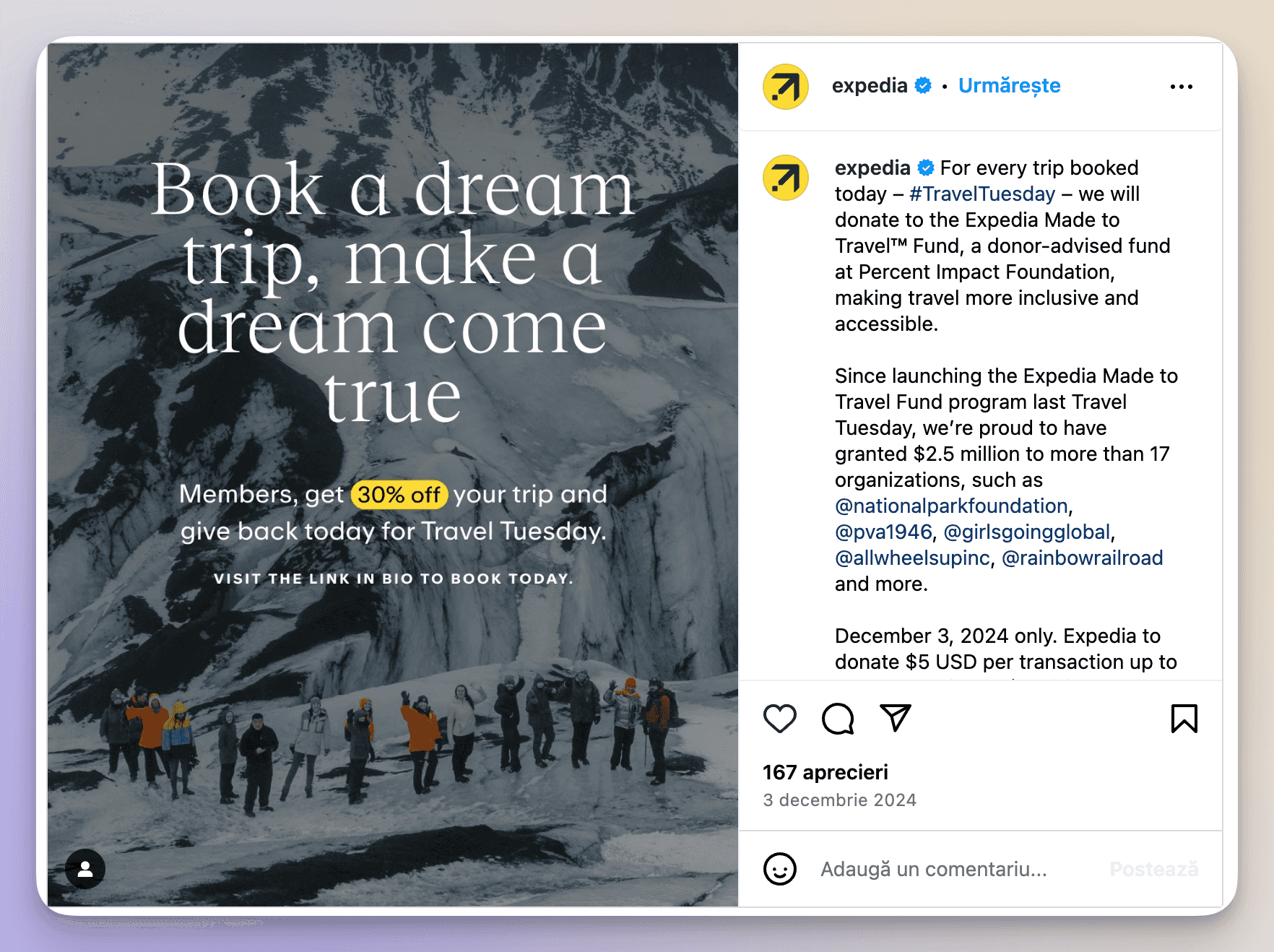
Social media tactics:
- Authentic moment storytelling;
- Emotional journey narratives;
- Travel transformation stories;
- Community support showcases.
The posts in this campaign received significant engagement, as shown by the analytics below.
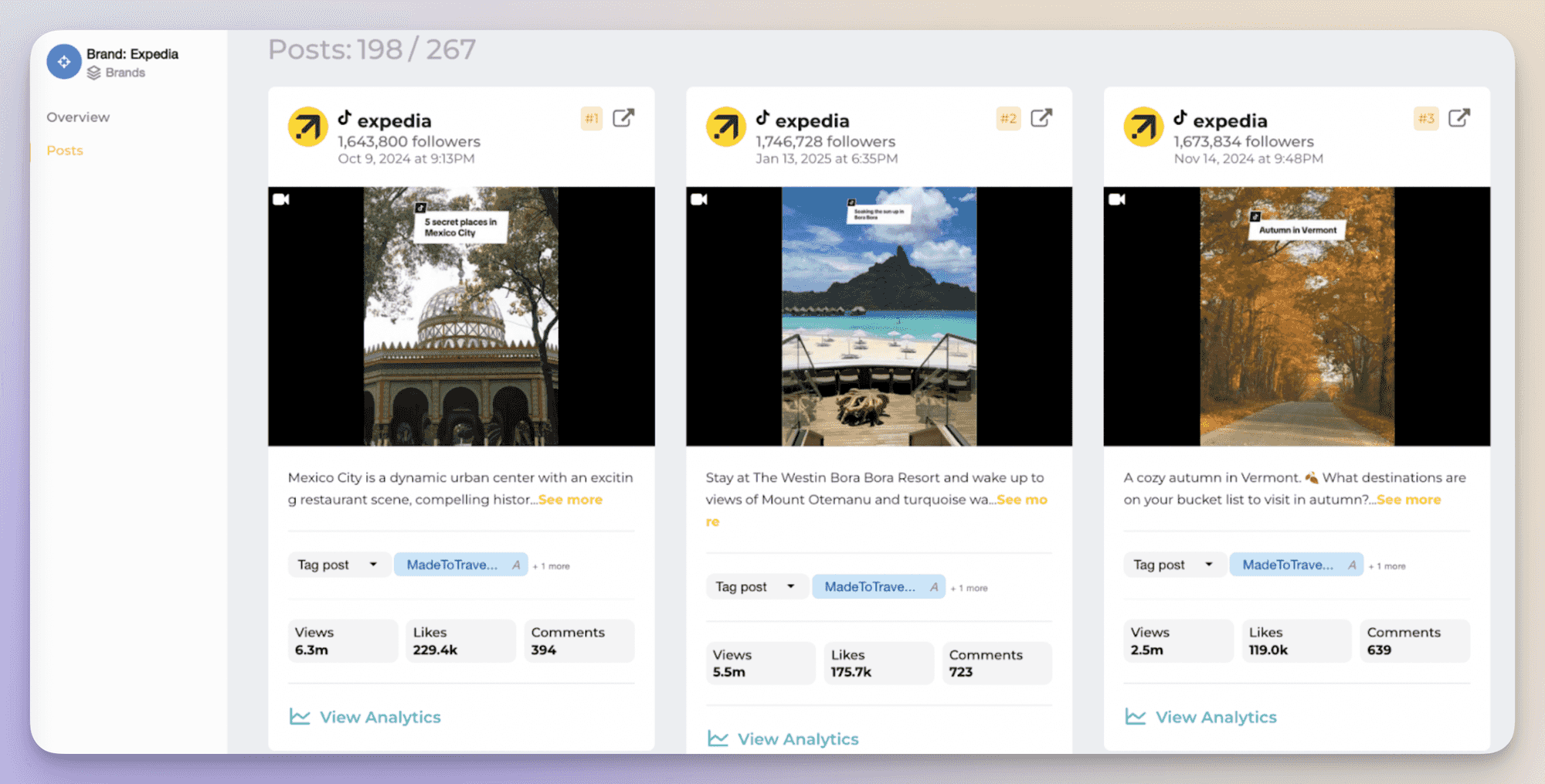
3 key lessons for social media managers:
- Skip the landmarks. Move beyond clichés to focus on genuine moments in your social media content.
- Measure impact. Using analytics to track how diverse content performs helps refine your social media strategy so you can improve campaigns in time.
- Connect content to action. Linking social posts to real initiatives like the Made to Travel Fund added credibility and elevated the whole brand.
💡 Insider tip: When developing travel content for social media, resist the urge to follow typical tourism imagery. Expedia's success came from focusing on the emotional moments of travel rather than the usual landmark shots.
#14. Appliances: Samsung's AR Innovation
When it comes to making technology tangible, Samsung turned to augmented reality.
This case study examines how AR bridges the gap between digital marketing and product experience — and how social media plays an important role in the process.
Objectives:
- Create interactive product experiences;
- Enhance customer decision-making;
- Drive engagement through AR features;
- Integrate AR across the product ecosystem.
Social media channels:
- Instagram AR filters;
- Facebook AR experiences;
- SmartThings app integration.
Other channels:
- AR Zone app;
- Product websites;
- Retail applications.
Social media tactics:
- Virtual product placement filters;
- AR home visualization tools;
- Interactive product previews;
- AR-enabled product features;
- Cross-platform AR integration.
This social media marketing case study showcases AR innovation through:
- The Frame TV visualization filter;
- AR Emoji Camera features;
- AR Doodle capabilities;
- Practical AR applications.
3 key lessons for social media managers:
- Make features shareable. AR tools that create engaging content encourage organic sharing.
- Blend utility and fun. As we've seen in multiple social media case studies, combining practical features with entertaining elements broadens the appeal and generates more engagement.
- Cross-promote AR experiences. Integrating AR across platforms and products creates a cohesive digital ecosystem.
💡 Insider tip: When developing AR features for social media, ensure they serve both marketing and practical purposes. Samsung's success came from creating AR experiences that didn't just promote products but became useful features in their own right.
#15. Beverages: Coca-Cola's "Taste the Feeling" Campaign
Sometimes, the biggest stories come from the smallest moments. This social media content strategy case study reveals how Coca-Cola turned everyday experiences into a global phenomenon.
Launched in 2016 as their largest marketing campaign ever, "Taste the Feeling" reimagined how a beverage brand could connect with audiences worldwide through relatable, emotional storytelling.
Objectives:
- Create universal emotional connections;
- Unify all product lines;
- Celebrate everyday moments;
- Drive global brand consistency;
- Generate shareable content.
Social media channels:
- Multiple social platforms;
- User-generated content channels;
- Interactive media platforms.
Other channels:
- Global anthem with Avicii
- Traditional advertising;
- Point-of-sale materials;
Social media tactics:
- Relatable moment storytelling;
- Inclusive representation;
- Interactive content sharing;
- Cross-cultural narratives;
- Music integration.
This social media marketing strategy case study achieved a massive scale:
- Reached over 200 countries;
- $1 billion+ investment;
- 3,000+ pieces of content, including UGC;
- Global brand unification;
- Cross-platform engagement.
3 key lessons for social media managers
- Scale through simplicity. You don't need complicated ideas. Universal emotions and simple moments translate across cultures.
- Content versatility is important for reach. Create various pieces of content for multiple channels while maintaining the core message.
- Music and influencers amplify reach. Maybe a partnership with Avicii is out of reach for your brand, but you can focus on local artists and micro-influencers to amplify impact.
💡Insider tip: When developing social media content, let your audience be your storytellers. Focus on moments your customers are already experiencing and sharing — friends hanging out, celebrations, and daily breaks. Use existing behaviors rather than trying to create new ones.
Ready to document your social media success? Before diving into our case study framework, make sure you have the right analytics tool.
How to write a social media case study?
After examining successful social media campaigns across different industries, let's break down how to create your own compelling case study.
Whether you're documenting campaign results or learning from others' successes, this social media template will help you structure your analysis effectively.
Why should you create a social media case study? Because compelling case studies help marketers learn from successful campaigns and demonstrate ROI. And because, let's face it, it's fun to showcase your hard work.
Here's your step-by-step guide to crafting an effective social media case study:
Introduction
The opening should immediately grab attention by highlighting what makes this campaign unique. Present the brand and explain why this particular case study matters to social media marketers.
Context
- Set the scene with the campaign background;
- Clearly state business objectives;
- Explain the problem or opportunity the brand addressed.
Strategy
- Define target audience demographics and behaviors;
- List all channels used and their specific roles;
- Detail content types and formats deployed.
Execution
- Provide campaign timeline;
- Document used resources;
- Note key collaborators and partnerships.
Performance analysis
- Choose relevant social media metrics based on objectives: engagement rates. reach and impressions, follower growth, click-through rates, conversion rates, social media ROI;
- Track KPI evolution throughout the campaign;
- Compare results against initial social media goals;
- Highlight unexpected wins;
- Document long-term brand impact;
- Choose the right social media analytics platform. Socialinsider helps you monitor engagement rates, reach, impressions, and custom KPIs across all major platforms.
Key takeaways
- Share 3-5 actionable lessons;
- Include tips & tricks for fellow marketers;
- Focus on learnings others can apply.
Visual evidence
- Include campaign screenshots;
- Show social media metrics;
- Add relevant graphics;
- Feature top-performing posts.
💡 Insider tip: When writing your case study, resist the urge to only showcase successes. Including the challenges faced and how you overcame them makes your case study more credible and valuable to other marketers.
Final thoughts
Every successful social media case study starts with solid data. While creativity and strategy drive campaigns, it's the metrics that tell the real story of their impact.
Ready to create your own case study? Start by gathering the right insights. Try Socialinsider's free 14-day trial to access in-depth analytics across all major social media platforms. You'll get the comprehensive metrics and competitive insights needed to build compelling case studies that showcase your social media success.
Turn your next campaign into a social media case study worth sharing.
FAQs on social media case studies
What is a social media case study?
A social media case study is a detailed analysis of a marketing campaign that documents the strategy, execution, and results. It tells the story of how a brand tackled specific challenges or opportunities through social media, providing concrete data and insights that other marketers can learn from. Think of it as a blueprint that shows what worked, what didn't, and why.
Why should you submit your social media case studies to competitions?
The answer depends on your role.
For brands:
- Validates your marketing innovation and success
- Attracts potential marketing partners and talent
- Generates positive PR and media coverage
- Strengthens your position as an industry leader
- Creates credibility with stakeholders and customers
- Provides recognition for your marketing team
For agencies:
- Showcases expertise to potential clients
- Differentiates your agency in a competitive market
- Helps retain existing clients by highlighting successes
- Attracts top talent looking to work on award-winning campaigns
- Builds agency reputation through industry recognition
- Creates case studies with third-party validation
When brands and agencies submit case studies together, they create a powerful narrative of collaborative success. This partnership approach often leads to stronger award submissions, as they can showcase both strategic thinking and real-world business impact. The resulting recognition benefits both parties through increased visibility, enhanced credibility, and new business opportunities.

